
Henry Scott Tuke, was an English artist; primarily a painter, but also a photographer. His most notable work was in the Impressionist style, and he is best known for his paintings of nude boys and young men.
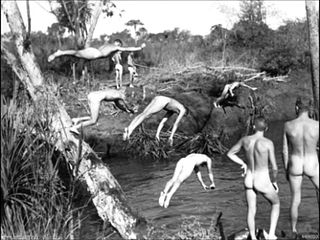
Nude swimming is the practice of swimming without clothing, whether in natural bodies of water or in swimming pools. A colloquial term for nude swimming is "skinny dipping".
Depictions of nudity include all of the representations or portrayals of the unclothed human body in visual media. In a picture-making civilization, pictorial conventions continually reaffirm what is natural in human appearance, which is part of socialization. In Western societies, the contexts for depictions of nudity include information, art and pornography. Information includes both science and education. Any ambiguous image not easily fitting into one of these categories may be misinterpreted, leading to disputes. The most contentious disputes are between fine art and erotic images, which define the legal distinction of which images are permitted or prohibited.

The Gulf Stream is an 1899 oil painting by Winslow Homer. It shows a man in a small dismasted rudderless fishing boat struggling against the waves of the sea, and was the artist's statement on a theme that had interested him for more than a decade. Homer vacationed often in Florida, Cuba, and the Caribbean.

John Reinhard Weguelin was an English painter and illustrator, active from 1877 to after 1910. He specialized in figurative paintings with lush backgrounds, typically landscapes or garden scenes. Weguelin emulated the neo-classical style of Edward Poynter and Lawrence Alma-Tadema, painting subjects inspired by classical antiquity and mythology. He depicted scenes of everyday life in ancient Greece and Rome, as well as mythological subjects, with an emphasis on pastoral scenes. Weguelin also drew on folklore for inspiration, and painted numerous images of nymphs and mermaids.
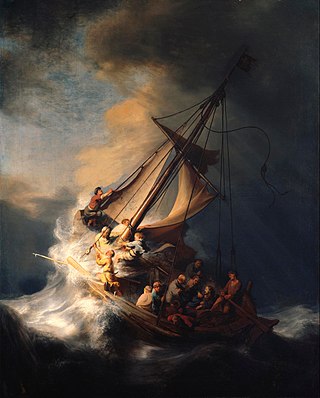
Marine art or maritime art is a form of figurative art that portrays or draws its main inspiration from the sea. Maritime painting is a genre that depicts ships and the sea—a genre particularly strong from the 17th to 19th centuries. In practice the term often covers art showing shipping on rivers and estuaries, beach scenes and all art showing boats, without any rigid distinction - for practical reasons subjects that can be drawn or painted from dry land in fact feature strongly in the genre. Strictly speaking "maritime art" should always include some element of human seafaring, whereas "marine art" would also include pure seascapes with no human element, though this distinction may not be observed in practice.

The Swimming Hole is an 1884–85 painting by the American artist Thomas Eakins (1844–1916), Goodrich catalog #190, in the collection of the Amon Carter Museum of American Art in Fort Worth, Texas. Executed in oil on canvas, it depicts six men swimming naked in a lake, and is considered a masterpiece of American painting. According to art historian Doreen Bolger it is "perhaps Eakins' most accomplished rendition of the nude figure", and has been called "the most finely designed of all his outdoor pictures". Since the Renaissance, the human body has been considered both the basis of artists' training and the most challenging subject to depict in art, and the nude was the centerpiece of Eakins' teaching program at the Pennsylvania Academy of the Fine Arts. For Eakins, this picture was an opportunity to display his mastery of the human form.
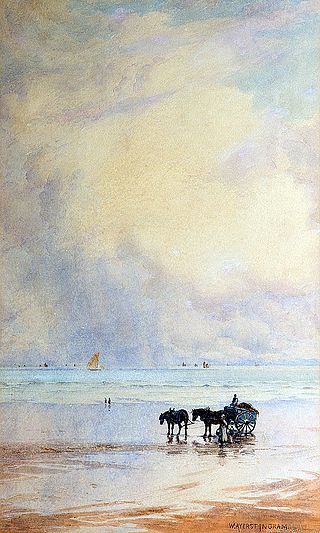
William Ayerst Ingram or W. Ayerst Ingram RBA was a painter and member of the Newlyn School. He did notable Landscape art and Marine art. In 1906 he joined the Royal Institute of Oil Painters and in 1907 he joined the Royal Institute of Painters in Water Colours.
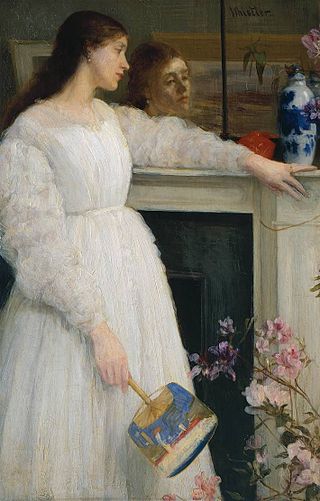
Symphony in White, No. 2, also known as The Little White Girl is a painting by James McNeill Whistler. The work shows a woman in three-quarter figure standing by a fireplace with a mirror over it. She is holding a fan in her hand, and wearing a white dress. The model is Joanna Hiffernan, the artist's mistress. Though the painting was originally called The Little White Girl, Whistler later started calling it Symphony in White, No. 2. By referring to his work in such abstract terms, he intended to emphasize his "art for art's sake" philosophy. In this painting, Heffernan wears a ring on her ring finger, even though the two were not married. By this religious imagery, Whistler emphasizes the aesthetic philosophy behind his work.

In the dull village is an etching and print made by David Hockney in 1966, one of series of illustrations for a selection of Greek poems written by Constantine P. Cavafy. It depicts two men lying next to each other in bed, naked from the waist up, with their lower halves covered by bedclothes.

August Blue is an oil-on-canvas painting by British artist Henry Scott Tuke. It depicts four youths in and around a boat, bathing in the sea. Tuke started the painting in 1893, probably en plein air on a boat in the harbour at Falmouth, Cornwall. The finished painting was exhibited at the Royal Academy summer exhibition in 1894, and immediately purchased for the Tate Gallery, where it remains to this day. It has a light Impressionistic style, possibly influenced by his travels to Italy, Corfu and Albania in 1892.

The Feast of Venus is an oil on canvas painting by Flemish painter Peter Paul Rubens, created in 1635–1636, now in the Kunsthistorisches Museum in Vienna. It is a fanciful depiction of the Roman festival Veneralia celebrated in honor of Venus Verticordia.
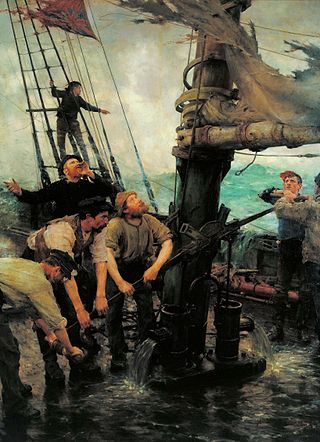
All Hands to the Pumps is an 1888–89 painting by British artist Henry Scott Tuke. At the time, the 21-year-old Tuke was living on an old French brig Julie of Nantes, which he anchored in Falmouth Harbour to use as a floating studio.

Ramsgate Sands, also known as Life at the Seaside, is an oil-on-canvas painting by William Powell Frith, made from 1851 to 1854, which depicts a beach scene in Ramsgate. The painting was Frith's first great commercial success: it was exhibited at the Royal Academy summer exhibition in 1854, and bought by Queen Victoria. Frith made a series of similar pictures, showing groups of people in contemporary scenes, including The Derby Day of 1858, The Railway Station of 1862, and Private View at the Royal Academy of 1883.
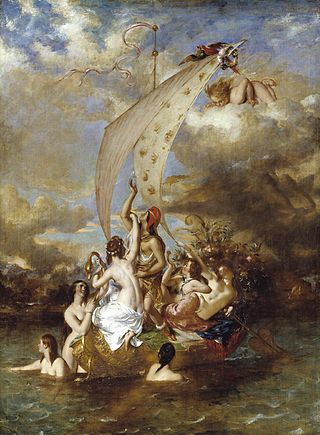
Youth on the Prow, and Pleasure at the Helm is an oil painting on canvas by English artist William Etty, first exhibited in 1832. Etty had been planning the painting since 1818–19, and an early version was exhibited in 1822. The piece was inspired by a metaphor in Thomas Gray's poem The Bard in which the apparently bright start to the notorious misrule of Richard II of England was compared to a gilded ship whose occupants are unaware of an approaching storm. Etty chose to illustrate Gray's lines literally, depicting a golden boat filled with and surrounded by nude and near-nude figures.

Musidora: The Bather 'At the Doubtful Breeze Alarmed', also known as The Bather, is a name given to four nearly identical oil paintings on canvas by English artist William Etty. The paintings illustrate a scene from James Thomson's 1727 poem Summer in which a young man accidentally sees a young woman bathing naked and is torn between his desire to look and his knowledge that he ought to look away. The scene was popular with English artists as it was one of the few legitimate pretexts to paint nudes at a time when the display and distribution of nude imagery was suppressed.

The Japanese ukiyo-e artist Kitagawa Utamaro made a number of prints depicting ama divers—women whose work is to dive for shellfish or pearls—catching haliotis abalone sea snails.

Hylas and the Nymphs is an 1896 oil painting by John William Waterhouse. The painting depicts a moment from the Greek and Roman legend of the tragic youth Hylas, based on accounts by Ovid and other ancient writers, in which the enraptured Hylas is abducted by Naiads while seeking drinking water.

The Lady of Shalott Looking at Lancelot is an oil-on-canvas painting by John William Waterhouse, completed in 1894. It measures 142.2 by 86.3 centimetres. The artist presented it to Leeds Art Gallery in 1895.

The Wrath Of The Seas is an 1886 painting by Russian artist Ivan Aivazovsky. Oil on canvas, it measures 70.1 × 110 cm, and is held in a private collection.





















